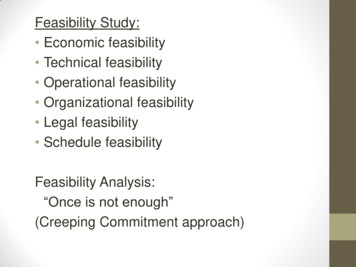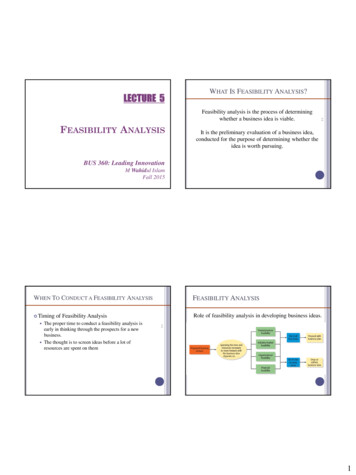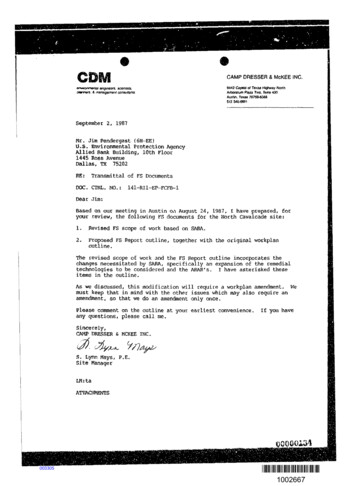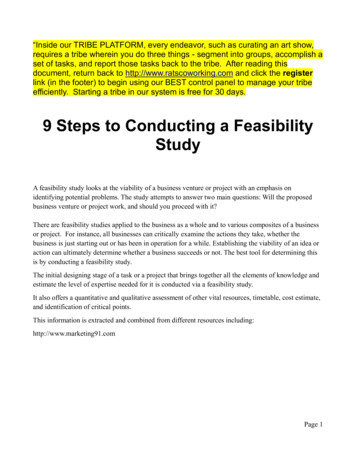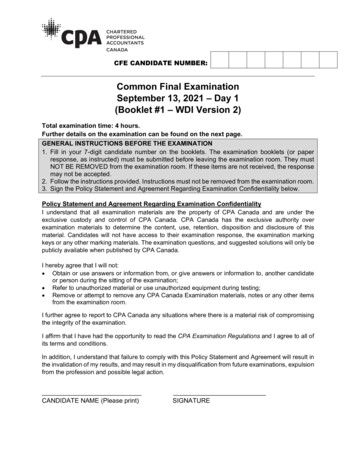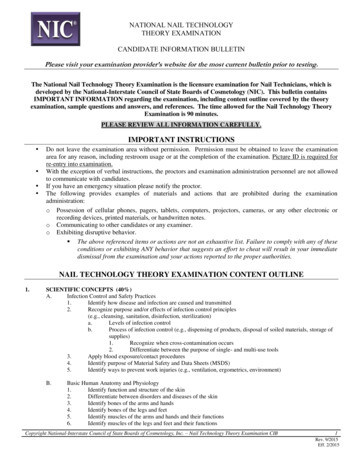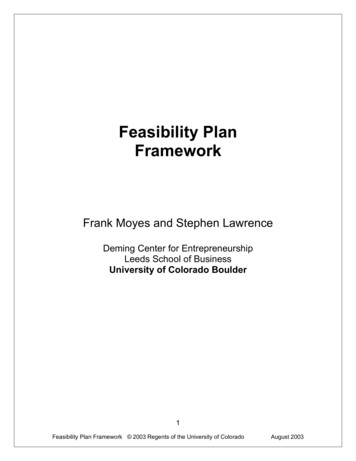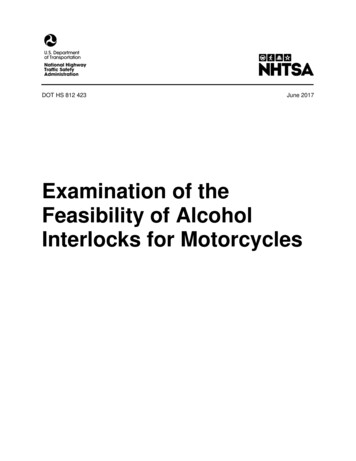
Transcription
DOT HS 812 423June 2017Examination of theFeasibility of AlcoholInterlocks for Motorcycles
DISCLAIMERThis publication is distributed by the U.S. Department of Transportation, NationalHighway Traffic Safety Administration, in the interest of information exchange. Theopinions, findings, and conclusions expressed in this publication are those of theauthors and not necessarily those of the Department of Transportation or the NationalHighway Traffic Safety Administration. The United States Government assumes noliability for its content or use thereof. If trade or manufacturers’ names or productsare mentioned, it is because they are considered essential to the object of thepublication and should not be construed as an endorsement. The United StatesGovernment does not endorse products or manufacturers.Suggested APA Format Citation:Marques, P. R., & McKnight, A. S. (2017, June). Examination of the feasibility of alcoholinterlocks for motorcycles (Report No DOT HS 812 423). Washington, DC: NationalHighway Traffic Safety Administration.
Technical Report Documentation Page1. Report No.2. Government Accession No.3. Recipient’s Catalog No.DOT HS 812 4234. Title and Subtitle5. Report DateExamination of the Feasibility of Alcohol Interlocks for MotorcyclesJune 20176. Performing Organization Code7. Authors8. Performing Organization Report No.Paul R. Marques and A. Scott McKnight9. Performing Organization Name and Address10. Work Unit No. (TRAIS)Pacific Institute for Research and Evaluation11720 Beltsville Drive, Suite 900Calverton, MD 20705-311111. Contract or Grant No.DTNH22-D-00035 Task #1712. Sponsoring Agency Name and Address13. Type of Report and Period CoveredNational Highway Traffic Safety Administration1200 New Jersey Avenue SE.Washington, DC 20590FINAL REPORTSeptember 2009–September 201014. Sponsoring Agency Code15. Supplementary NotesRandolph Atkins, Contracting Officer Representative (COR). Kathryn Wochinger assisted with the final report.16. AbstractIn 2011 some 30 percent of the 4,612 motorcycle operators involved in fatal crashes had blood alcohol concentrations(BACs) of .08 g/dL or higher. Although alcohol ignition interlocks are a common sanction to deter impaired driving,they are not typically used on motorcycles. This report reviews information on alcohol ignition interlocks to helpdetermine whether they can be an appropriate DUI countermeasure when installed on motorcycles operated byconvicted DUI offenders. The report summarizes issues of perceived liability, technical barriers, statutory or legislativebarriers, and other factors related to this issue.Information was collected from a variety of sources. Findings reflect discussions with senior executives from interlockcompanies operating in the United States, government authorities knowledgeable of their State’s interlock program andexisting laws and practices, interlock installers, end-user DUI offenders, and an analysis of the breathe test data frominterlocks used by 407 motorcyclists.Reported liability and safety concerns about motorcycle interlocks usually center on the running (often rolling) retests.Retesting in a moving automobile involves some risk; retesting while operating a motorcycle is an even greater safetyhazard if the cycle is in motion. Technical concerns usually center on protection of the hardware from weather exposureand the added time needed for custom installation. The low volume of business does not justify investing in designimprovements; and State interlock standards – written for passenger vehicles– complicate safety issues for motorcycles.The authors conclude that there are no technical barriers to the more widespread use of interlocks on motorcycles;however, at present, there is little incentive for manufacturers to build an interlock ideally suited to the motorcycleenvironment, and that most State standards, which call for regular testing while the motorcycle is running, pose acredible safety hazard that needs to be overcome.17. Key Words18. Distribution Statementalcohol, interlock, motorcycle,Document is available to the publicfrom the National TechnicalInformation Service, www.ntis.gov.19 Security Classif. (of this report)20. Security Classif. (of this page)21 No. of PagesUnclassifiedUnclassified55Form DOT F 1700.7 (8/72)i22. Price
Table of ContentsExecutive Summary .1Objectives .2Methodology .2Findings .2Discussions With Interlock Companies .3Discussions With State Officials .3Discussions With Riders Who Had Used Motorcycle Interlocks .4Analysis of Interlock Breath Test Logs .4Background .5Early Development of Alcohol Interlocks .5Interlock Features and Effectiveness .6Basic Device Characteristics .6Evidence for Automobile Interlock Program Effectiveness.6Barriers to Better Program Effectiveness .6Number of Interlocks Installed .7Alcohol Ignition Interlocks on Motorcycles .7Methodology .8Findings .9Interlock Manufacturers and Suppliers.9How Many Motorcycle Interlocks Are Out There? . 10Preliminary Discussions With Manufacturers . 11Possible Problems With Motorcycle Interlocks Identified by Company Contacts . 12Possible Solutions for Motorcycle Interlock Feasibility . 12In-Depth Discussions With Manufacturers and Installers . 13Perspectives of Manufacturers . 13Perspectives of Installers . 17Interviews With State Officials . 19State Vehicle Code . 20State Policies . 20Requests for Motorcycle Interlocks . 21Prevalence of Motorcycle Interlocks. 21Summary of Laws, Policies and Prevalence . 22Analysis of Breath Test Event Records from Motorcyclists . 22Subject Level Analysis of Motorcycle Interlock Data . 22Event Level Analysis of Motorcycle Interlock Data . 28Morning Failed BAC Tests. 31Summary Interlock Data from Motorcycles . 31Discussion With Motorcyclists Who Used Interlocks . 32Administrative Issues . 32Operational Issues . 32Interlock Retests on Motorcycles . 33Riding Retests. 33ii
Circumvention . 34Security . 34Equipment Malfunctions . 34Motorcycle Interlock Usage . 35Summary and Conclusions . 35Feasibility . 35Cost . 36Safety Considerations . 36Program Standards for MC Interlocks . 36Final Note . 36References . 38Appendix A:State Laws, Policies, and Practices Regarding Motorcycle Interlocks . A-1Appendix B:Observations of an Installation of a Draeger Safety XT Interlock on a Motorcycle . B-1Appendix C:Survey Information on Interlock Penetration . C-1iii
List of TablesTable 1 Interlock manufacturers and major installers operating in the United States . 10Table 2 Motorcycle interlock data, participants by State. 23Table 3 Descriptive motorcycle interlock statistics at the subject level . 24Table 4 BAC ranges and frequency from motorcycle interlock data. 28Table 5 2009 Data: States by total interlocks and interlocks per .08 fatalities . C-2List of FiguresFigure 1 Duration of motorcycle interlock installed period in the analysis file . 24Figure 2 The average/offender number of failed BAC tests per fail to category shown. . 26Figure 3 ID of motorcycle interlock operators’ failed BAC tests per start attempts. 27Figure 4 ID of motorcycle interlock operators’ failed BAC tests per days of interlock use . 27Figure 5 Monday to Friday motorcycle interlock BAC tests ( .025 g/dL) by hour . 29Figure 6 Saturday to Sunday motorcycle interlock BAC tests ( .025 g/dL by hour . 29Figure 7 Failed motorcycle interlock BAC tests (BAC .025 g/dL) by day . 30Figure 8 Failed automobile interlock BAC tests (BAC .025 g/dL) by day in New Mexico . 30Figure 9 Alcohol crashes with driver BAC .08 by day of week; N 9,884 (U.S. 2007 dta) . 31Figure 10 2008 Honda Shadow Cruiser-type Motorcycle . B-1Figure 11 Wire cable runs beneath the fuel tank toward the battery . B-2Figure 12 Seat removed, battery hookup connectors . B-2Figure 13 Handlebar secure pouch with interlock at rest atop . B-3Figure 14 Handlebar protective pouch closed . B-3Figure 15 Arrangement for download of data to computer via handset. B-4Figure 16 2009 State-by-State estimates of interlocks installed, based on 11 of 12 companies reporting . C-1iv
Executive SummaryThis report reviews information on alcohol ignition interlocks to help determine whetherthey can serve as an appropriate DUI countermeasure when installed on motorcycles operated byoffenders convicted of driving under the influence of alcohol. While most licensed motorcycleoperators can also drive a regular passenger vehicle, there are some riders that either do not owncars or that prefer to ride a motorcycle at least some of the time during their interlock stipulatedperiod. The report also summarizes findings uncovered in the process of trying to understand anddisentangle issues of perceived liability, technical barriers, statutory or legislative barriers, andother factors related to motorcycle interlock usage.The number of motorcyclist fatalities from 2002 to 2011 increased from 3,270 to 4,612,and peaked at 5,312 in 2008 (NHTSA, 2013b). A large portion of fatal motorcycle crashes areassociated with alcohol impairment. In 2010 some 28 percent of motorcycle riders involved infatal crashes were alcohol impaired with blood alcohol concentrations (BACs) of .08 grams perdeciliter or higher. In 2011 this increased to 30 percent of motorcycle riders with BACs of .08grams per deciliter or higher in fatal crashes. The role of alcohol in fatal motorcycle crashes isgreater than for any other vehicle type. This has resulted in an increased focus upon reducingimpaired motorcycle operation. In recent years, alcohol ignition interlock devices have been usedto curb impaired operation of passenger vehicles. It may be that these devices could be usefullyextended to help reduce impaired riding, as well.Today, the average efficacy of interlock programs – estimated from a dozen studies andpertaining only to the period while the interlock is installed on the vehicle – has been estimatedas a 64-percent reduction of DUI recidivism (Willis, Lybrand, & Bellamy, 2004; Marques, 2009;Elder et al., 2011). All the evidence bearing on efficacy and effectiveness of interlocks as a DUIcountermeasure, and nearly all of the installations have been on 4-wheeled passenger vehicles orlight trucks. Motorcycle interlocks are relatively uncommon and have never been subjected to anefficacy evaluation.The apparent potential of ignition interlocks to reduce impaired riding suggested the needfor an independent study to understand the feasibility of alcohol ignition interlocks formotorcycles. However, as of June 2010, the majority of manufacturers and installation-onlyservice providers did not install their interlock devices on motorcycles, and/or interpret Stateregulations as disallowing motorcycle installation. On the other hand, at least two of the majormanufacturers will allow their devices to be installed at service centers if staff members there arefamiliar with motorcycle wiring. Those companies that do permit installation require some formof liability waiver signed by the motorcycle operator. There are States with laws and policies thatprohibit the installation of interlocks on motorcycles, and other States that permit or even requirecompanies to install interlocks on motorcycles.1
ObjectivesThe central objective of this project was to determine the feasibility of using alcoholignition interlocks in motorcycles. The project also sought to determine and describe the state ofthe practice of motorcycle interlocks, which involved examining the following factors. The number of motorcycle interlocks in useThe number of manufacturers and suppliers of motorcycle interlocksManufacturers’ experiences using motorcycle interlocksState highway officials’ experiences and opinions of motorcycle interlocks as a tool todeter/punish impaired ridingAnalysis of breath test logs from riders using motorcycle interlocksExperiences of motorcycle riders operating motorcycles with interlocksTo meet the objectives of the project, the researchers acquired information on motorcycleinterlocks from the following sources. Manufacturer and/or installer discussionsDiscussions with officials in States with high-volume interlock programsAnalysis of breath test log files of motorcyclists with interlocks installedDiscussions with motorcyclists who have operated with interlocksMethodologyGeneral installation and operational issues have been gleaned from discussions withinformed parties at both the supplier and governmental levels. An estimation of the State-byState penetration of interlocks when this study began in 2009 (both the total number of units inservice and the per capita number of devices) is provided in graphic and tabular form inAppendix C. This accounting of penetration at the State level guided the project’s selection ofStates in which to conduct conversations with knowledgeable professionals about their Stateinterlock programs, and the States’ position on interlocks and motorcycles.We identified major suppliers and installers of interlocks to determine the approximatenumbers of devices installed annually in all vehicles, including motorcycles, and asked themwhether they installed on motorcycles in the past or whether they were willing to currently installtheir equipment on motorcycles. While there are two manufacturers (Draeger Safety andLifesafer Interlock) that permit installations on motorcycles, there were once six willing to do so;those who no longer are willing to do so reported having had problems with equipment loss,malfunction, breakage, rider dissatisfaction, and the need for additional staff time to completeinstallations. On the other hand, we learned that if States require a motorcycle option, suppliersmust be willing to install interlocks on motorcycles as a condition of operating in the State.Under such circumstances, most manufacturers seem willing to reconsider their positions.FindingsThe findings from this project are summarized in four major subsections coveringinformation learned from (1) manufacturers and installers, (2) government officials from Stateswith the highest rates of interlock use, (3) analysis of breath test records from 407 motorcycle2
interlock users accumulated from November 2003 to June 2010, and (4) DUI offenders who hadinterlocks installed on their motorcycles (end users).Discussions With Interlock CompaniesThe executives and installers from interlock companies differ on the question of howmuch safety risk is involved in operating a motorcycle with an interlock. To the extent that asafety risk is perceived, it primarily involves the performance of retests. 1 The technical barriersin manufacturing a motorcycle specific device can be overcome, but it does not appear that thereis enough potential motorcycle interlock business to warrant the investment at this time. Twomanufacturers currently accommodate motorcycle rider DUI offenders using the existingautomobile interlocks, which can be made to work adequately well on a motorcycle. A variety ofcompromises are necessary to adapt automobile interlocks to motorcycles related to issues suchas weather exposure (e.g., moisture, dust), vibration, secure storage, operator notification forretesting with auditory signals, and power draw. A rough estimate suggests that motorcycleinterlocks likely represent less than 0.1 percent of all interlocks in service.Discussions With State OfficialsWe contacted States having 2,000 or more interlocks as well as States that exceeded theestimated mean rate of interlock installations per capita in an attempt to understand their lawsand policies. As of 2009, when this study began, there were 19 States with at least 2,000interlocks and 27 States with more than 1,000 interlocks in service. 2State laws differ on the extent to which motorcycles are addressed in operating standardsfor interlocks. We contacted the 19 States with more than 2,000 interlocks, the 17 States withmore than the national average of interlocks on a per capita basis, and 2 States with smallerinterlock programs to obtain information on their interlock laws with regard to motorcycles.Some States require offenders to equip all vehicles they own, rather than just those theydrive. Of the 38 States examined 15 had such laws, 16 did not, 4 had laws requiring this incertain cases and 3 of the experts speaking on behalf of their States could not comment on theirlaws regarding motorcycles. Of the 38 States that were asked to provide information, 2 Statesrequire owners of motorcycles to equip them with interlocks, 5 States specifically disallow theinstallation of interlocks, 8 States specifically allow them, 8 States have laws that requiremotorcycle owners to install motorcycle interlocks but don’t enforce them, 14 States have nopolicy regarding motorcycle interlocks, and there was 1 State for which the contact could notprovide information about the States’ policies. Regarding the prevalence of motorcycle interlocksamong those 38 States, 22 States reported having no interlocks on motorcycles, 11 Statesreported having some and there were 5 States for which we were unable to determine theprevalence, again due to a lack of information available from the State contact. The acquiredinformation is summarized in Appendix A: State Laws, Policies, and Practices RegardingMotorcycle Interlocks.1Retests are sometimes referred to as running retests.This study’s methodology used the 2009 estimates provided in Appendix C, which were the most current interlockpenetration estimates available at the time of the study. As of 2012 there were 31 States with at least 2,000interlocks and 33 States with more than 1,000 interlocks (Roth, 2012).23
Discussions With Riders Who Had Used Motorcycle InterlocksWe held discussions with four motorcyclists who rode with interlocks about theirexperiences using the interlocks and their perceptions of safety hazards, if any. Three were maleand one female; three used cruiser motorcycles and one rode a sport bike. Two performed rolling(moving) retests, two retested while stopped. Each of the four had to make a concerted effort toget the devices installed on their motorcycles, and all were pleased that they could legallyoperate a motorcycle by using an interlock, and at a relatively little perceived safety risk. Forthem the conveniences and pleasures of riding legally outweighed the burdens of testing andretesting. The riders who performed rolling retests stated that retesting in stop–and-go trafficposed a more significant safety risk than retesting on the open road.Analysis of Interlock Breath Test LogsData from motorcycle rider breath test logs spanning approximately 7 years ofinstallations were made available by Draeger Safety Interlock. This provided an opportunity forus to examine operator performance data. The data represented 407 different motorcycleinterlock user episodes of a median installed period of 7 months. The patterns in the data weresimilar to analyses from interlocks installed on passenger cars except that, over comparableperiods of time, the number of startup BAC tests from motorcycle interlocks was about 1/3 thenumber found with automobiles. This result is as expected since motorcycles, in general, logfewer travel miles than passenger vehicles. As found with car interlock data, more than 99percent of all BAC tests at startup are passed and about 40 percent of riders did not log failedBAC tests (a finding that is comparable to that reported in Marques, Voas, Roth, & Tippetts[2010] in New Mexico). About 25 percent of the motorcycle riders, those with the highest ratesof failed interlock BAC tests, fail most often on an initial start attempt.4
BackgroundThe purpose of this project is to review issues germane to the feasibility of alcoholignition interlocks for motorcycles. It provides background information on issues related to thehistorical development of the alcohol ignition interlock, the use of motorcycles by impairedoperators, and the current status of motorcycle interlocks in the United States.The number of motorcyclist fatalities from 2002 to 2011 increased from 3,270 to 4,612,and peaked at 5,312 in 2008 (NHTSA, 2013b). Alcohol has been involved in a higher proportionof those crashes than for any other vehicle type, resulting in an increased focus upon reducingimpaired motorcycle operation. In recent years the use of alcohol ignition interlock devices tocurb impaired operation of passenger vehicles has increased substantially. It may be that thesedevices could be usefully extended to help reduce impaired riding, as well. However, there areStates with laws and policies that prohibit the installation of interlocks on motorcycles, and otherStates that permit or even require companies to install interlocks on motorcycles.Early Development of Alcohol InterlocksThe first interlock was developed by the Borg Warner Company, an affiliate of GeneralMotors, in 1969. After performance-based interlocks were tried and rejected in the 1970s,alcohol-sensing devices, initially using non-specific alcohol sensors, became the standardthrough the 1980s. These semiconductor type (Taguchi) interlocks were sturdy and got the fieldmoving but did not hold calibration very well, were sensitive to altitude variation, and reactedpositively to non-alcohol sources. Commercialization and more widespread adoption of thedevice was delayed pending improvement of systems for preventing circumvention. By the early1990s, the industry began to produce second-generation interlocks with more reliable andaccurate fuel cell sensors.Alcohol ignition interlock devices were used more widely in the United States afterpassage of the 1986 Farr-Davis Driver Safety Act in California, which provided for a pilot test ina few California counties. Soon after, other States enacted legislation that supported use of thistechnology. As legislation expanded through the late 1980s, NHTSA, in an effort to assist theStates, published guidelines, referred to as Model Specifications for Breath Alcohol IgnitionInterlock Devices (hereafter Model Specifications), for States to evaluate and certify theadequacy of the interlock ha
Findings reflect discussions with senior executives from interlock companies operating in the United States, government authorities knowledgeable of their State's interlock program and existing laws and practices, interlock installers, end-user DUI offenders, and an analysis of the breathe test data from interlocks used by 407 motorcyclists.


